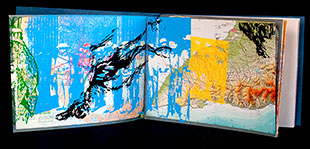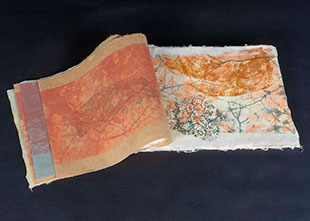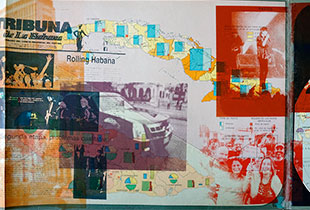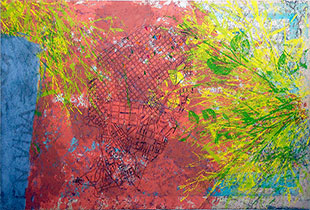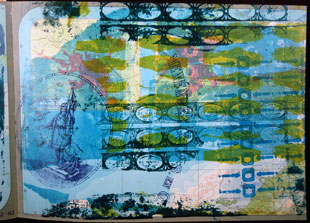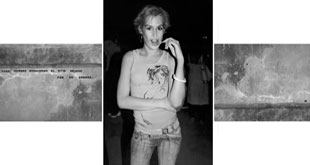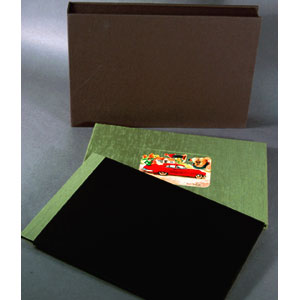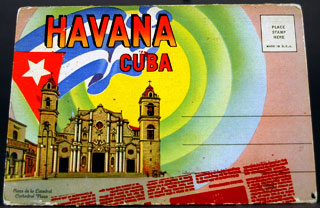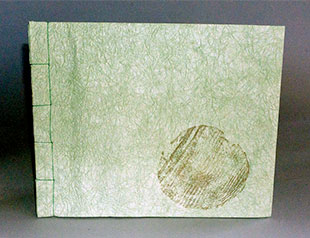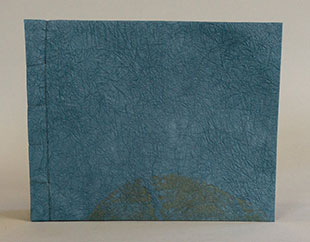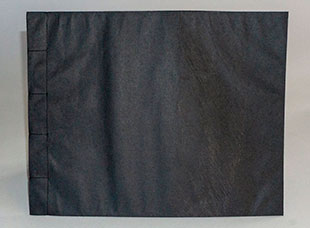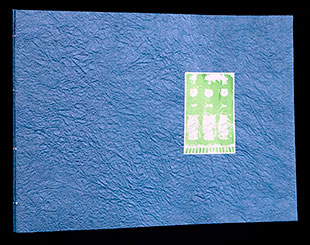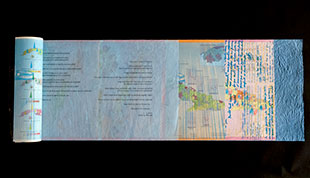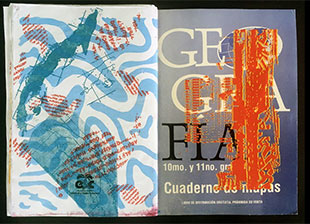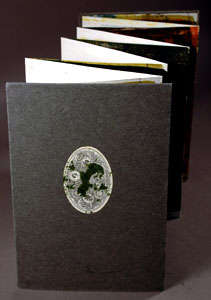
|
Red Trillium Press ~
Massachusetts |
Share this page: |
|
| Exhibition, The Book A Contemporary View: “Steven Daiber trained in drawing and painting … Daiber has been making books … and owns the Red Trillium Press in Florence, Massachusetts. Daiber describes himself as the son of two biologists and a perpetual student of nature. He connects his interest in nature to the time he spent on the Delaware seashore collecting specimens and assisting with his father’s research. He says that he still collects, dissects, and draws the animal and plant life around him.” | ||
| Cuban books by Red Trillium Press Natural History work |
||
| Steven Daiber has traveled to Cuba annually since 2001. In Havana, he has the opportunity to work with several print shops and many different Cuban artists. This section of books are those produced as a result of his visits and relationships with artists and print shops in Cuba. | ||
Toxicodendron radican 104 x 10 " open. Silkscreen on 1978 Atlas de Cuba pages. Kyoseishi Sora paper for cover. Silkscreen by Steven Daiber, Jessica Vazquez Quintana and Impresiones Serigrafias. Bound by Daiber. Steven Daiber: "'Toxicodendron radicans' is a collaboration with the Cuban artist Ibrahim Miranda. Printed in the summer heat of 2019 at the Taller de Serigrafía René Portocarrero, Havana and in January 2020 at Impresiones Serigrafías SDA, Havana. "Toxicodendron radicans is the genus and species for poison ivy." |
||
Otoño 17 x 12.5 x .5 inches. Woodcuts. Printed on Dieu Donné Paper Mill, interleafed with Yasuo. Kyoseishi for the cover paper. Steven Daiber: “’Otoño’ is a celebration of a friendship founded in the 2006 over a silkscreen press in a Cuban print studio, and strengthened with a passion for libros de artistas and many glasses of rum. ‘Otoño’ was printed over three long days in October 2019 at Red Trillium Press using six screens, one stone, a section of a tree, 12 colors and 212 impressions. “In October 2019 Hanoi Perez visited with me in Western Massachusetts for the second time, with his first visit being in the spring of the year 2013. What a joy it was to share with Hanoi the New England fall foliage and bring together a series of images using paper that I’ve had squirreled away for over thirty years. While we worked, we talked of US politics, the environment, friendship and family. “Hanoi made the observation that Cuba is in the midst of a Civil War with Cubans against Cubans. Because of the US policies towards Cuba and a strong anti-Castro Miami Cuban stance, he believes that US Cuban support of the Republican party is a fight against individual Cubans on the island. “As we worked on this book the Trump administration was working to withstand an impeachment hearing. Of all the various global crisis the most important one is climate change. Hanoi mentioned as I printed my woodcuts that we were looking at life and death with his images evoking the beauty of the natural world in the fall of the year and my hardline woodcuts evoking a more dire image." |
||
Roiling Habana 104 x 9 5/8" extended. Silkscreen overprinting on pages from the 1978 Atlas de Cuba, bound as an eight page accordion book. Essays printed in 12 page pamphlet, sewn binding, in wrappers with title and illustration on front cover. Maps and text pamphlet laid in a hardcover turquoise wrap with a magnetic closer. Signed and dated by the artist. Numbered. Steven Daiber: "On May 14, 2004, we stood on the Malecón witnessing thousands of people marching in protest to the Bush administration’s decision to strengthen of the embargo against Cuba. Our spring 2016 trip witnessed events unimaginable a decade earlier. On March 20, 2016, President Obama visited Havana, the first President in over 80 years. On March 25, 2016, the Rolling Stones gave a free concert to over 600,000 people in Havana. We were there with friends who were in awe. On April 19, 2016, Fidel spoke for the last time at the National Party Congress. "A palimpsest of images obscures the pages of the Atlas de Cuba that record the week’s activities. There are documents from the Cuban newspapers, photos off the television of Barrack Obama and Raul Castro and notes reminding us of the ongoing by-weekly fumigation of every apartment for Zika virus. The week progresses across the atlas finishing with the euphoria of Cubans witnessing Mick Jagger and the Rolling Stones. "There are three bi-lingual essays by the artist Steven Daiber, by Gladys Linares, a retired Cuban secondary school teacher, and by Josuhe H. Pagliery, a young Cuban video game artist." Colophon: "Roiling Habana was printed in April 2016 at Taller de Serigrafia Rene Portocarreo, Havana on the 1978 Atlas de Cuba, published for the twentieth anniversary of the Cuban Revolution." |
||
| La acera / The Side Walk By Steven Daiber Havana: Red Trillium Press, 2007 - 2015. Edition of 10. 19 x 15" folder in chipboard with cloth spine, title on front cover. Contains: Maps: 18.8 x 15" closed extending to 88.5", 12 pages, double sided; Essay: 18.75 x 15", 8 pages. Participants: Serigraphy by Steven Daiber in 2007 and 2011 with assistance from Carlos Delgado at the Taller de Serigrafia Porto Carrero, Havana, Cuba; Additional serigraphy by Michael Fitzpatrick, Florence, Massachusetts; Editor, Jean Zimmer, Northampton, Massachusetts; Translator, Yudania Mone Linares, Havana, Cuba; Type setting, Lisa Carta, Florence, Massachusetts. Paper for the serigraphy: 1979 Atlas Nacional de Cuba. Text printed on Hahnemühle Bugra. Text in Spanish and English. Numbered and signed by Daiber. Red Trillium Press: "Everyone walks in Cuba – often for pleasure and always for the necessities of life. A slow stride is needed when the Cuban sun hammers you into a red-eyed, burnt and sweaty puddle. But everyone walks in Cuba. You walk to the agro for fruits and vegetables. You traverse neighborhoods in search of the lowest prices on soap, coffee, Soya oil, or deodorant. Or you may stroll along the Malecón sea wall in the evening to cool off and take in the sea and cityscape. “La Acera is a walking map of Havana recording the daily lives of Red Trillium Press traveling to Havana for over 15 years. La Acera is printed on the 1979 Atlas National de Cuba in 2007 & 2011 and is accompanied by an essay describing the artist’s family lived experiences in La Habana. “The first printing in 2007 is an impression of sidewalks throughout Havana. The first page is the sidewalk in Plaza de Armas in Habana Vieja of beautiful limestone cut to expose the geology of sea. The second image is the sidewalk in concrete, with repairs and graffiti and footprints cast while the concrete was wet. The third is sidewalk in disrepair, worn down to the dirt with passing many feet and plants surviving at the edges. “Returning in 2011 to the Taller de Serigrafia Porto Carrero, three maps of Havana recording the history of Daiber’s travels in Havana were printed. The first map is of Habana Vieja, the second map is of the city – La Habana, the third map is of Vadado the neighborhood. “Walking in Havana is a delight for the foreigner, who watches the city breathe change. For the Cuban, though, life in Havana more often remains la lucha.” $2,000 |
||
La playa Essay by Norberto Marrero Pírez (English translation by Yudania Monés): "It is neither the bather clinging to the sand, nor the sun radiating tons of silence. It is not even the wind enveloping everything with tits ravenous caresses. It is perhaps the night in which, gagged by the stillness of the stars, that very bather clinging to the sand drinks from a slow and dark stream. Everything is less painful; any defeat is easier to bear within silence. And since all bearable things are eternal, so is the dream of that bather clinging to the sand, his eyes examining the horizon, relishing the calmness of the waters, once again before the immensity of his dream." |
||
El Muro: The Wall 9 x 14”; 18 leaves (2 pink free end sheets, 1 pink divider, 10 photograph fold outs, 5 text pages). Ten black and white triptych photographs, two bilingual essays, and a glossary. Printed by duotone offset lithography on Shine, a luminous mica-coated acid-free paper, with three sheets of translucent magenta paper separating the photographs and essays. The essays, by Eduardo Hernández Santos and Abel Sierra Madero (noted Cuban ethnologist), are presented in Spanish and English. Also included is a bi-lingual translation of the lines by poet Virgilio Piñera and the individual letters Hernandez added to the photographs of the wall, which are abbreviations of pejorative terms used in Cuba to refer to homosexuals. Wire-o binding opening to 20" so the triptychs may be viewed in full. Deluxe edition of 50: Signed by Santos, the photographer. Includes two signed original prints as well as a copy of the standard version. Housed in a clamshell box. Red Trillium Press: "Eduardo took these photographs in the summer of 2005. Working in the dark of night he printed them on expired photo paper and with exhausted chemistry, in his bedroom-turned-darkroom in Centro Habana. Hernández then adhered lines of poetry by the late Cuban poet and playwright Virgilio Piñera to the photographs of the wall, metaphorically breaking down the mortar that supports the hateful edifice of heteronormativity that confines his subjects to the edge of the city. "Eduardo Hernández Santos’ El Muro is a composite chronicle of late-night life at Havana’s utmost limit of the city: the seafront wall, popularly known as the Malecón. El Muro is a significant visual source of constantly-thwarted gay nightlife in Havana, but above all it is a social document about the members of a historical underclass emerging from hiding to contest efforts to control their lifestyles, to proclaim their normality and their non-conformity of the status quo. These powerful images express the subjects’ abiding desire to reaffirm their existence. "Hernández photographs combine the anthropological and the voyeuristic. The series confirms that human sexuality is a continuum of possibilities that encompasses not only the subtle but also the sensational. Each photograph is also a remarkable testimony to human endurance and triumph of the spirit, motivated by humiliation, scorn, derision, homophobia, and intolerance. These are the people Hernández celebrates with his photographs. He presents them not as passive players but as people who struggle (though more quietly than not) to oppose their discrimination even when opposition is a tough choice." |
||
Almendrones 13.75 x 9.5 x 1.875". Two books, one with the prints, one with background information on the project and the artists, housed in a linen clam box. Woodcut, lithography, silkscreen, and intaglio printed at the Taller Nelson Domingo, Taller Experimenta De Graphic, and private tallers in Havana. Copies 16-25 are for each participating artist. Colophon: "Collaborative project with 10 Cuban printmakers, who each offer one image of the culture of aging American cars that populate their country where recycling of materials is a necessity of life and creative art form.” Artists: Laura Hidalgo Cabrer (woodcut with handcoloring and presstype), Luis Lamothe Duribe (linoleum), Orlando Montalván (callograph), Julio César Peña Peralta (lithography and linoleum), Yordanis García Delgado (lithography), Jesús Roberto Reyes Romeu (Chucho) (linoleum), Hanoi Pérez Cordero (silkscreen), Isolina Limonta Rodríguez (lithography), Dania Fleites (etching), and Alejandro Ramón Saínz Alfonso (silkscreen and linoleum). |
||
Postcards 4.25 x 6.125". 16 postcards. Accordion fold souvenir package. Silkscreen. Postcards consists of souvenir postcards overprinted with found historical images plus images that appeared in Cuban newspapers in the spring of 2006. Juan Leal printed the historical lithographic images from original stones and Hanoi Perez did the silkscreen printing, which was completed in April 2006 at the Taller Nelson Domingo, Havana, Cuba. |
||
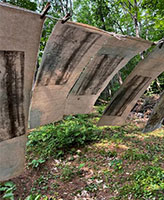 |
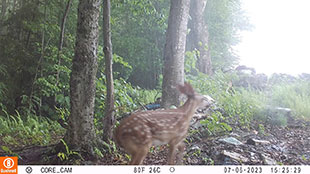 Natural History books – Steven Daiber: “These books Winter and Spring are the first of 4 seasonal books observing the world from the quiet of my studio. Each of the books is the same size, format though the edition size may vary. … each of the books works with hidden images created by folding the paper and binding on the cut edge.” |
|
Spring in the time of ROE – SHOOTINGS 13 x 11.5 x .5”. Paper: Kyoseishi, Yatsuo, Koz. Bound in paper wraps. Signed by the artist. Steven Daiber: “Spring in Goshen is a lovely time of year; delicate greens of plants awaking from winter, migratory birds returning, spring peepers, the buzz of the insects and Red Trilliums in bloom. The loss of women’s right to abortion, continued school shootings, war in the Ukraine, are only a few of the unbalances that humans have brought onto themselves and very ground we live with.” $900 |
||
Summer in the time of smoke, heat, and rain 13 x 11.5 x .5”. Paper: Kyoseishi, Yatsuo, Koz. Bound in paper wraps. Signed by the artist. Steven Daiber: “Summer in Goshen, MA is a paradise; gardens, sounds of timbering and construction, birds nesting, and young animals wander across my field cameras. The summer of 2023 started with forest fires, smoke and air unfit to breath. Across North America a disjointed jet stream holds a heat doom stationary in the south and west while overwhelming New England in rain. The currents in the Atlantic Ocean are changing and scientists are in awe of the rapidness of the climatic catastrophe. Al Gore’s Inconvenient Truth is no longer a film to contemplate as climate change is happening faster than ever predicted. “What can I do? Try to garden harder, improve my pollinator gardens, remove invasive plants, educate my neighbors to native flora and fauna? Small hope and anger to cling to at a time when the climate roils and global leaders’ fiddle.”
$900 |
||
Winter in the time of COVID 13 x 11.5 x .5”. Paper: Kyoseish, Yatsuo, Hanji, Asarakusui and Glassine. Bound in paper wraps. Signed and numbered by the artist. Steven Daiber: “Winter in Goshen MA is dramatic, frozen ponds, windswept snow, refracted sun light on ice crystals and the sound of a frozen landscape. “The horror of vaccination denial, the January 6 attempted overthrow of the U. S. government, ideals why my father’s generation went to war are being lost and history repeats itself. War is here; carefully crafted for decades on the non-white male populous through voting and gun legislation, land control and policing. Using fear of the other through ‘The War on Drugs and Poverty’ with slight-of-hand propaganda is affectively blinding and deafening the nation.
$900 |
||
| Red Trillium Press Out of Print and SOLD titles: |
||
Donde esta el Cristal? 104 x 10 inches open. Accordion structure. Text in Spanish and English. Silkscreen on 1978 Atlas de Cuban pages. First printed in the June heat of 2019 at the Taller de Serigrafía René Portocarrero, Havana, Cuba on the 1978 Atlas de Cuba. Text added later at Red Trillium Press. Pamphlet bound with Kyoseishi Sora as a cover paper. Silk screen printing by Daiber and Quintana. Numbered. Steven Daiber: "I arrived on May 27 [2019] to the José Marti national Airport as always. Noticeable the moment I walked out of the airport was the lack of old American cars. I did not see an American car parking lot, where were they? "'Donde estas el Crystal' reflects the current atmosphere in Havana with the withdrawal of US tourism and other measures by the Trump administration to eliminate opening of the US – Cuban relations during the Obama administration. "'Hace mucho calor!'; 'This is a difficult time it may be as bad as the special period.'; 'We stood in line for four hours waiting for chicken, then there was no chicken.' "In these moments I wasn’t sure whether the people were talking about the temperature or their frustrations." As well as text being printed as normal on pages, quotes are also printed in one line across the bottom of the page like a running ticker tape of conversation: "Yes, things will get worse here, there is no peace of mind …" |
||
| El que vive de ilusiones muere de desengaño. He who lives with illusions dies of disenchantment By Steven Daiber Havana: Red Trillium Press, 2015. Edition of 6 + Artist Proof. 13 x 4" closed, extends to 34"; 7 text leaves, 4 map leaves (double-sided). Silkscreen on a 1979 Cuban atlas with text digitally printed on Thai Unryu, and Japanese Yatsuo paper. Whirlwind binding with Kyoseishi Sora paper. Printed at the Taller Bablu Aye, Havana Cuba. Set in ITC Goudy Sans. Text in Spanish and English. Translation by Udania Mones Linares. Signed, dated, and numbered on the colophon by Daiber. For display purposes includes 15.25 x 5.75" vertical oblong bag with handles to hold rolled book in. Each bag text varies with responses to Daiber's questions printed on the exterior. Steven Daiber: "A collaboration with Cubans ages 12 to 77 reflecting upon the changing relations with Cuba and the United States. "We have witnessed an improvement in dialogue between Cuba and the US. Since my return to Havana in January 2015, this new dialogue has been a point of discussion with every Cuban I have met. I asked Cubans ages 12 -72 two questions. What are your expectations for the future? Do you have any concerns with how the US and Cuba can work together?" (SOLD/Out of Print) |
||
Huracán 6 x 9.5". Silkscreen and lithography on Cuban school textbook. Printing in Cuba and Massachusetts. Numbered. Steven Daiber: "The text forming the hurricane patterns are random digital coding and the 1823 quote from John Quincy Adams.
"Over printed on the reverse cover paper is an image of the 50 black flags installed in front of the US Interest Section in 2006 protested the Bush administration and an image of the US Embassy taken from where the flag poles were installed and removed in 2020." United States Interests Section in Havana, wikipedia 7/24/20: "The United States Interests Section of the Embassy of Switzerland in Havana, Cuba or USINT Havana … represented United States interests in Cuba from September 1, 1977, to July 20, 2015. It was staffed by United States Foreign Service personnel and local staff employed by the US Department of State, and located in a multi-story office building on the Malecón across from the Plaza de la Revolución in Havana. The mission resumed its role as the Embassy of the United States in Cuba on July 20, 2015, following the normalization of diplomatic relations between the two countries. "In January 2006, USINT Havana began displaying messages on a scrolling 'electronic billboard' in the windows of their top floor, including the George Burns quotation, 'How sad that all the people who would know how to run this country are driving taxis or cutting hair.' Following a protest march, the Cuban government erected a large number of poles, carrying black flags with single white stars, obscuring the messages. In June 2006, Granma International referred to the billboard as 'the systematic launching of the crudest insults of our people via the electronic billboard, which, in violation of the most elemental regulations of international law, they think they can maintain with impunity on the facade of that imperial lair.' "In June 2009, the electronic billboard was turned off, because according to the US State Department, the billboard was not effective in delivering information to the Cuban people." |
||
Tobacco 10 x 67" extended, accordion bound. Densely overprinted lithographic images of Cuban tobacco art. Printed from original stones at Taller Experimenta De Grafica, Havana, Cuba. Steven C. Daiber: "In September 2003 I went to Havana, Cuba for ten months. In Havana I was able to print in three different print shops. First printing at the sate run Taller Experimenta De Grafica where there is an archive of hundreds of lithographic stones containing images used in the Cuban tobacco industry, advertising, North American comics, and even Christmas wrapping paper. In addition there are two smaller state owned Tallers and at least half dozen private workshops." |
||
Page last update: 05.30.2025
Home | About Us | Contact Us | New Arrivals | Fine Press & Artists' Books | Broadsides |Resource Books | Order/Inquiry
Copyright © 2021 Vamp & Tramp, Booksellers, LLC. All rights reserved.
